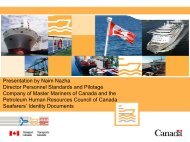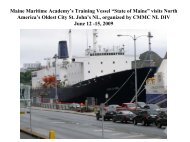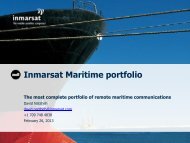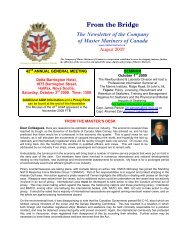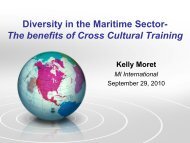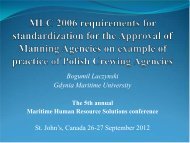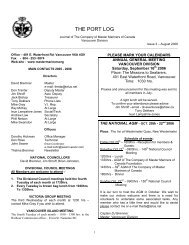From the Bridge - Company of Master Mariners of Canada
From the Bridge - Company of Master Mariners of Canada
From the Bridge - Company of Master Mariners of Canada
Create successful ePaper yourself
Turn your PDF publications into a flip-book with our unique Google optimized e-Paper software.
“<strong>From</strong> <strong>the</strong> <strong>Bridge</strong>” August 2007<br />
Canadian Coast Guard Today, Tomorrow<br />
One <strong>of</strong> our members, Capt Tony Potts, until recently in command <strong>of</strong> our major ice-breaker, Louis S. St. Laurent<br />
and now Acting Director, CCG Operations (Atlantic) described <strong>the</strong> Canadian Coast Guard, its fleet <strong>of</strong> specialised<br />
ships, <strong>the</strong> expertise <strong>of</strong> its personnel, its pr<strong>of</strong>essional delivery <strong>of</strong> services to o<strong>the</strong>r government agencies including<br />
<strong>the</strong> fairly recent addition <strong>of</strong> small CCG vessels carrying armed RCMP <strong>of</strong>ficers on security patrols. Ships and<br />
crews are ageing but a small fleet replacement program is in place and new vessels to increase maritime security<br />
nationally will be added to <strong>the</strong> fleet. The CCG has its role in Maritime Security, in planning, operations and<br />
logistical support.<br />
Ships taken up from Trade – is STUFT an Option for <strong>Canada</strong><br />
Of particular interest to merchant mariners were <strong>the</strong> papers on Legislative Authority for Requisitioning <strong>of</strong> Shipping<br />
for Emergency Operations, <strong>the</strong> Use <strong>of</strong> National Flag Ships <strong>of</strong> <strong>Canada</strong> and Ship Chartering for DND Missions. In<br />
<strong>the</strong> first <strong>of</strong> <strong>the</strong>se papers, <strong>the</strong> speaker referred to Britain’s requisition <strong>of</strong> shipping in time <strong>of</strong> war and ship chartering<br />
for <strong>the</strong> Falklands in 1982. Under <strong>the</strong> Emergencies Act which replaced <strong>the</strong> War Measures Act, <strong>the</strong> Government<br />
may take action in <strong>the</strong> interests <strong>of</strong> public welfare and order as well as to cope with international emergencies<br />
affecting <strong>Canada</strong> but <strong>the</strong> legislation does not appear to include <strong>the</strong> requisition <strong>of</strong> Canadian shipping although this<br />
could be added.<br />
Mr Heinz Gohlish, a UK Consultant who had served in <strong>the</strong> Canadian Navy, addressing <strong>the</strong> subject <strong>of</strong> Canadian<br />
flag shipping stated that as <strong>of</strong> April ’07, <strong>the</strong>re were 362 Canadian registered commercial ships <strong>of</strong> 500gt and over.<br />
However he added that many <strong>of</strong> <strong>the</strong>se ships (bulk carriers, tankers, self-unloaders, research vessels) are not<br />
suitable for military sealift operations. Some were unsuitable because <strong>of</strong> size or draft limitations. He whittled <strong>the</strong><br />
list away until he had 132 “possibles” and finally only 16 “probables”. The speaker noted that big <strong>of</strong>f-shore supply<br />
vessels could be useful but many Canadian supply vessels are in several parts <strong>of</strong> <strong>the</strong> world and a major owner <strong>of</strong><br />
such vessels in Halifax has sold his fleet to American interests. In emergency chartering <strong>the</strong>re has to be preplanning,<br />
identification <strong>of</strong> suitable ships, communications with owners, negotiation <strong>of</strong> terms & conditions and<br />
consideration <strong>of</strong> suitable crews.<br />
A Canadian Second Registry – A Source <strong>of</strong> Suitable Ships<br />
Mr Gohlish noted that in <strong>the</strong> Lebanon evacuation, <strong>Canada</strong> had to charter foreign-flag shipping, Greek and<br />
Turkish. With no time to plan for suitable shipping <strong>the</strong>re were some problems and it was very expensive but <strong>the</strong><br />
evacuation was successful. Mr Gohlish suggested that <strong>Canada</strong> should develop a more diverse Canadian fleet<br />
through active fiscal encouragement. The tonnage tax, successful in Britain is not a subsidy but tax is paid on <strong>the</strong><br />
ship’s tonnage, not on its earnings. The UK has a “second registry” in <strong>the</strong> Isle <strong>of</strong> Man. Norway has an<br />
international “second registry”. The optimum solution is to have a national flag fleet suitable for Government<br />
requisition or charter in time <strong>of</strong> crisis.<br />
Ship Chartering for DND Missions was <strong>the</strong> title <strong>of</strong> a paper presented by L.Col Martha Stouffer <strong>of</strong> Support<br />
Command, Canadian Forces, Ottawa. Her Unit <strong>of</strong> DND considers <strong>the</strong> chartering <strong>of</strong> suitable ships and invites<br />
owners to submit bids. She stated that Canadian Forces would wish to time charter a suitable ro-ro vessel with a<br />
deck capable <strong>of</strong> sustained helicopter operations. The speaker had not considered a bareboat charter option, nor<br />
did she comment on <strong>the</strong> command <strong>of</strong> a chartered vessel and its crew. She was reminded <strong>of</strong> <strong>the</strong> disastrous<br />
charter <strong>of</strong> <strong>the</strong> GTS Katy seven years ago.<br />
I found it most interesting to hear how navies have, in recent disasters, reacted successfully and to hear about <strong>the</strong><br />
problems <strong>of</strong> finding a suitable merchant ship for sustained Canadian Forces operations until <strong>the</strong> Navy has its own<br />
Joint Support Ship.<br />
For a Conference Fee <strong>of</strong> $150, which included two lunches, a banquet dinner, a working brunch on <strong>the</strong> Saturday<br />
and all <strong>the</strong> c<strong>of</strong>fee one would wish, it was a real good deal. The speakers’ presentations are available on <strong>the</strong><br />
host’s web-site http://www.cfps.dal.ca Incidentally, I registered as a member <strong>of</strong> CMMC.<br />
Capt Angus McDonald. Maritimes Division<br />
San Pedro Bay Ports Clean Air Action Plan<br />
In 2006 <strong>the</strong> Californian Ports <strong>of</strong> Los Angeles and Long Beach adopted <strong>the</strong> landmark San Pedro Bay Ports Clean<br />
Air Action Plan (CAAP) to curb port-related air pollution from trucks, ships, locomotives, terminal equipment and<br />
harbour craft. The CAAP is <strong>the</strong> boldest air quality initiative by any seaport, consisting <strong>of</strong> wide-reaching measures<br />
to significantly reduce air emissions and health risks while allowing for <strong>the</strong> development <strong>of</strong> port efficiency projects.<br />
(www.port<strong>of</strong>losangeles.org) (www.polb.com)<br />
Following are two measures that have developed from this plan.<br />
6



